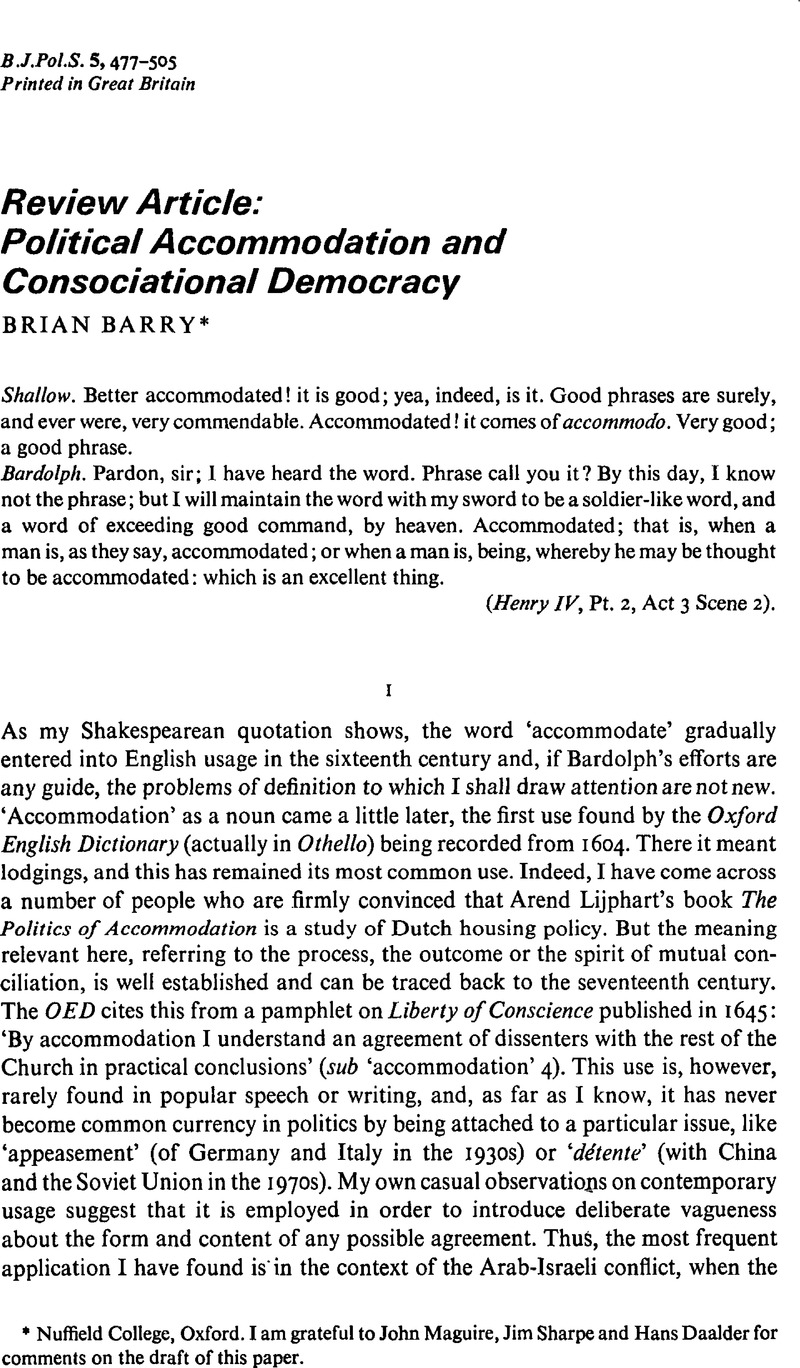Article contents
Review Article: Political Accommodation and Consociational Democracy
Published online by Cambridge University Press: 27 January 2009
Abstract

- Type
- Review Article
- Information
- Copyright
- Copyright © Cambridge University Press 1975
References
1 Lijphart, Arend, The Politics of Accommodation: Pluralism and Democracy in the Netherlands (Berkeley and Los Angeles: University of California Press, 1968), pp. 103–4.Google Scholar
2 Lijphart, A., ‘Consociational Democracy’, World Politics, XXI (1969), 207–25.CrossRefGoogle Scholar Reprinted in Kenneth McRae, ed., Consociational Democracy: Political Accommodation in Segmented Societies (Toronto: McClelland and Stewart, The Carleton Library, 1974), 70–106. I shall give page references for this and other articles in McRae’s convenient collection, citing it as ‘McRae’. The quotation in the text appears on p. 79.
3 Lijphart, , ‘Consociational Democracy’ in McRae, p. 79Google Scholar, my italics.
4 Val R. Lorwin, ‘Belgium: Conflict and Compromise’, printed for first time in McRae, 179–206; reference to p. 206.
5 Lijphart, , ‘Consociational Democracy’ in McRae, p. 75.Google ScholarAlmond’s, article ‘Comparative Political Systems’ appeared in the Journal of Politics, XVIII (1956), 391–409.CrossRefGoogle Scholar
6 McRae, p. 13; Lijphart in McRae, pp. 74–5; Lorwin, p. 36 in McRae.
7 Daalder, H., ‘The Consociational Democracy Theme’, World Politics, XXVI (1974), 604–21, p. 609.CrossRefGoogle Scholar
8 Steiner, J., Amicable Agreement versus Majority Rule: Conflict Resolution in Switzerland (Chapel Hill: University of North Carolina Press, revised and enlarged edition [translated from German edition of 1970] 1974).Google Scholar
9 Dahl, R. A., ed., Political Oppositions in Western Democracies (New Haven, Conn.: Yale University Press, 1966), p. 371.Google Scholar
10 Steiner, , Amicable Agreement, p. 3.Google Scholar
11 Steiner, , Amicable Agreement, p. 4.Google Scholar
12 Steiner, , Amicable Agreement, p. 6.Google Scholar
13 Steiner, , Amicable Agreement, pp. 4–5.Google Scholar
14 Steiner, , Amicable Agreement, p. 37.Google Scholar
15 Steiner, , Amicable Agreement, p. 199.Google Scholar
16 Barber, Benjamin R., The Death of Communal Liberty: A History of Freedom in a Swiss Mountain Canton (Princeton, N.J.: Princeton University Press, 1974), p. 252.Google Scholar
17 Barber, , Death of Communal Liberty, pp. 253–4.Google Scholar
18 Steiner, , Amicable Agreement, p. 19.Google Scholar
19 For this interpretation, see Barber, , Death of Communal Liberty, pp. 258–74.Google Scholar
20 Gerhard Lehmbruch, ‘A Non-Competitive Pattern of Conflict Management in Liberal Democracies: the Case of Switzerland, Austria and Lebanon’, printed for the first time in McRae, 90–106, p. 92.
21 Steiner, , Amicable Agreement, p. 4.Google Scholar
22 Keech, William R., ‘Linguistic Diversity and Political Conflict: Some Observations Based on Four Swiss Cantons’, Comparative Politics, IV (1972), 387–404, p. 388.CrossRefGoogle Scholar
23 Steiner, , Amicable Agreement, p. 49.Google Scholar
24 Steiner, , Amicable Agreement, p. 49.Google Scholar
25 Steiner, , Amicable Agreement, p. 49.Google Scholar
26 In Conflict Regulation in Divided Societies (Cambridge, Mass: Center for International Affairs, Harvard University, Occasional Papers in International Affairs, No. 29,1972).Google Scholar
27 Steiner, , Amicable Agreement, p. 257.Google Scholar
28 Steiner, , Amicable Agreement, p. 252.Google Scholar
29 Steiner, , Amicable Agreement, p. 33.Google Scholar
30 Steiner, , Amicable Agreement, p. 33.Google Scholar
31 Steiner, , Amicable Agreement, pp. 54–5.Google Scholar
32 Pulzer, P. G. J., ‘The Legitimizing Role of Political Parties: the Second Austrian Republic’, Government and Opposition, IV (1969), 32–44.Google Scholar Reprinted in McRae under title ‘Austria: the Legitimizing Role of Political Parties’, 157–78, p. 158.
33 Lijphart, , ‘Consociational Democracy’, in McRae, p. 75.Google Scholar
34 Bluhm, William T., Building an Austrian Nation: the Political Integration of a Western State (New Haven and London: Yale University Press, 1973), p. 71.Google Scholar
35 Pulzer, , ‘Austria’, in McRae, pp. 173–4.Google Scholar
36 See Pulzer, , ‘Austria’, in McRae, pp. 168–9.Google Scholar
37 Lijphart, , ‘Consociational Democracy’, in McRae.p. 75.Google Scholar
38 Bluhm, , Building an Austrian Nation, p. 68, fn. 37.Google Scholar
39 Bluhm, , Building an Austrian Nation, p. 25.Google Scholar
40 Bluhm, , Building an Austrian Nation, p. 24.Google Scholar
41 Bluhm, , Building an Austrian Nation, p. 86.Google Scholar
42 Bluhm, , Building an Austrian Nation, p. 85.Google Scholar
43 Bluhm, , Building an Austrian Nation, p. 34Google Scholar.
44 See Lijphart, , ‘Consociational Democracy’, in McRae, p. 77.Google Scholar
45 See Lijphart, , ‘Consociational Democracy’, in Mcrae, , p. 76.Google Scholar
46 Dahrendorf, Ralf, Society and Democracy in Germany (London: Weidenfeld and Nicolson, 1968), p. 269.Google Scholar
47 Bluhm, , Building an Austrian Nation, p. 70.Google Scholar
48 Powell, G. Bingham Jr, Social Fragmentation and Political Hostility: an Austrian Case Study (Stanford, Calif.: Stanford University Press, 1970).Google Scholar
49 Calculated from Table 19, p. 61, of Powell, Social Fragmentation.
30 Powell, , Social Fragmentation, p. 71.Google Scholar
51 Lehmbruch, Gerhard, ‘The Ambiguous Coalition in West Germany’, Government and Opposition, III (1968), 181–204CrossRefGoogle Scholar, reprinted in abridged form in Dogan, Mattei and Rose, Richard, eds., European Politics: a Reader (London: Macmillan, 1971), 549–63, p. 553.CrossRefGoogle Scholar
52 Quoted by Allison, Graham T. in the front of Essence of Decision (Boston: Little, Brown, 1971), no reference supplied.Google Scholar
53 Almond, G. A., Flanagan, S. C. and Mundt, R. J., eds., Crisis, Choice and Change: Historical Studies of Political Development (Boston: Little, Brown, 1973).Google Scholar
54 See Keech, , ‘Linguistic Diversity’, p. 387.Google Scholar
55 Keech, , ‘Linguistic Diversity’, pp. 400,401,402.Google Scholar
56 Lorwin, , ‘Belgium: Conflict and Compromise’, in McRae, p. 197.Google Scholar
- 109
- Cited by


